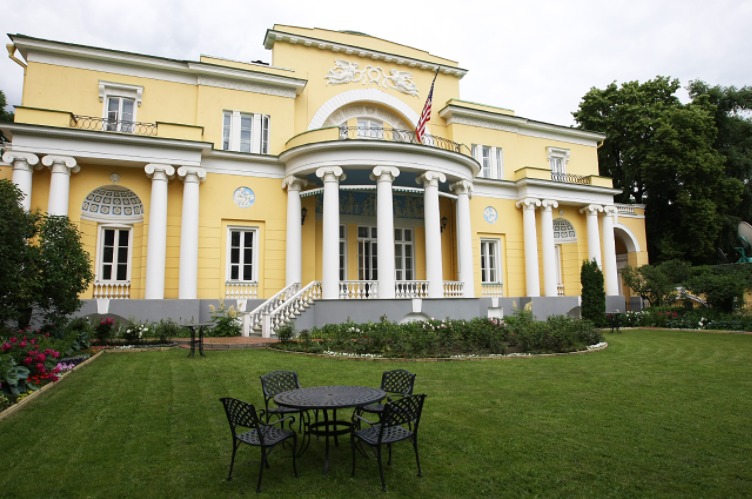6 Secrets to the Residence of the US Ambassador in Moscow
The mansion on Staropeskovskaya Square was chosen by chance as the place for the satanic ball in Mikhail Bulgakov’s novel The Master and Margarita. If the walls of the building could speak, then they would tell many secrets and legends. The Spaso House is located next to the Arbat, and since 1993, every US ambassador to Russia lives here, but this has not always been the case, the newspaper writes Russia Beyond.

Photo: Valeriy Yevseyev / US Embassy Moscow
Bulgakov was greatly impressed by the Spring Festival, which was held on 24 on April 1935 of the Year at Spaso House. It was one of the most luxurious events that the US mission abroad conducted. Were invited outstanding figures of the world of the arts, among whom was Bulgakov. According to his wife, after the holiday he radically rewrote the chapter “The Spring Ball of the Full Moon” (“Satanic Ball”) in his famous novel “The Master and Margarita”. The fountains of wine and champagne, the orchestra and the singing of birds actually existed.
1. Kennedy's bust hid from Reagan
Upon entering the building, guests can see the flags and the fireplace, on which stands the bust of former President John. F. Kennedy.
In May 1988, Spaso House welcomed President Ronald W. Reagan, who went to Moscow to meet with Secretary General Mikhail Gorbachev. In addition to organizing an extensive and labor-intensive home renovation, the State Department also sent food and china to Moscow to organize an official dinner. As observers have noted, the Kennedy bust "has moved to a more inconspicuous angle."
2. Spyware in coat of arms
The house stores many stories of espionage. The most famous story about the "bug" in the wooden coat of arms of the United States. The Soviet Union learned that Ambassador William Harriman was a passionate collector of rare wood handicrafts. In 1945, he was presented with a sophisticated wooden copy of the Great Seal of the United States.
The souvenir was so beautiful that the ambassador hung it on the wall in his office. Of course, he did not know that inside there was a “bug” called “Chrysostom” (also known as “Golden Mouth”).
Chrysostom worked for a long time and overheard four ambassadors. The furniture changed, and the wooden product remained on the wall. The Americans discovered it in 1952, when they caught a radio signal. Now this historical object is stored in the CIA Museum.
3. Uncontrolled seals in the main hall
During the Christmas season of 1934, the first US ambassador to the Soviet Union, Christian Bullitt, instructed his translator, Charles Thayer, to organize "real fun" for all American citizens in Moscow.
The Moscow circus lent him three seals. In the evening, guests gathered in the main hall, and the seals “entered”, carrying a Christmas tree and trays with glasses and a bottle of champagne on their noses. The seals then performed many tricks, after which their trainer suddenly fainted. Without his control, the seals began to scamper throughout the house, and embassy staff tried to drive them to safety. Fortunately for Thayer's career, Ambassador Bullitt was not present at the party as he was temporarily recalled to Washington.
4. Previously, the owner of the house was "Siberian American"
Nikolai Vtorov moved to Moscow from Siberia at the beginning of the 20 century. By that time, he was already a successful entrepreneur and owned a number of industrial enterprises and banks.
In February 2017 of the year, taking up archival materials, the magazine Forbes compiled a list of the richest people who lived in Tsarist Russia. Vtorov was second with a capital of more than 60 million gold rubles ($ 720 million).
Because of his ability to make money, Vtorov was nicknamed "Siberian American."
After the 1917 revolution of the year, according to some historians, Vtorov swore allegiance to the new authorities, but in May 1918 was killed under mysterious circumstances in his office. The descendants of Vtorov went abroad, and his mansion in the center of Moscow was seized by the state and occupied by high-ranking officials. Subsequently, it became the residence of the US ambassador to 1933, when the United States and the Soviet Union established diplomatic relations.
5. The biggest chandelier in Moscow
The mansion was built from 1913 to 1915 year and was equipped with the latest technology of the era. Designers also did not hold back when it came to the interior. The main hall, 25 meters long, is crowned with a high vaulted ceiling and a huge chandelier. It is believed that this chandelier, made of Russian crystal, remains the largest chandelier in Moscow today.
Read also on ForumDaily:
Poisoning Russian intelligence officer in Britain and Russian spies in the United States
How Belarusian passed in the USA from scavenger in strip-bar to trucker
Our emigration: how the Russian family opened a successful business in Mexico
Subscribe to ForumDaily on Google NewsDo you want more important and interesting news about life in the USA and immigration to America? — support us donate! Also subscribe to our page Facebook. Select the “Priority in display” option and read us first. Also, don't forget to subscribe to our РєР ° РЅР ° Р »РІ Telegram and Instagram- there is a lot of interesting things there. And join thousands of readers ForumDaily New York — there you will find a lot of interesting and positive information about life in the metropolis.











